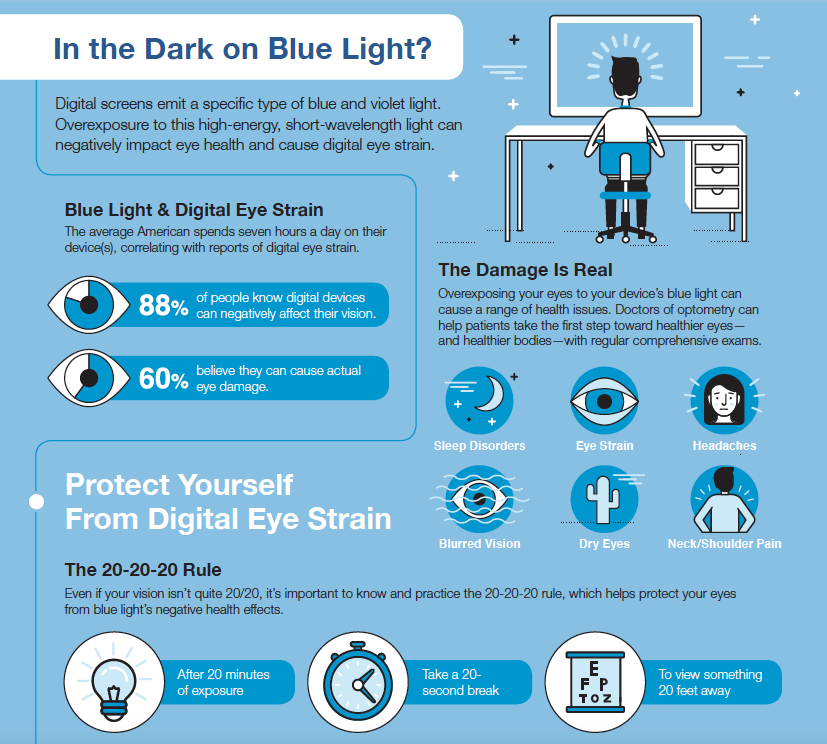March is National Save Your Vision Month. Each March, the American Optometric Association (AOA) launches a campaign to increase awareness about good eye care. The 2017 campaign is focused on two dangers to vision: digital eyestrain and the impact of blue light on vision and overall health.

The AOA understands that digital devices are an essential part of our daily lives. For this reason, it is offering information on the risks of blue light exposure and tips for using digital devices more safely.
Blue Light Exposure and Digital Eyestrain Awareness
Use of digital technology has exploded over the past decade, and as a result, blue light exposure has also increased. Blue light is on the short wavelength end of the visible spectrum. Compared to longer wavelength light, blue light emits a higher energy, which penetrates deeply into eyes and can lead to overexposure. Blue light overexposure can contribute to:
— Long-term vision problems, shoulder and neck pain, and dry eyes
— Retina damage
— Cataracts
— Age-related macular degeneration (AMD)
People who stare at screens for hours at a time often end up suffering from physical eye discomfort, known as digital eyestrain, AOA survey, the average person in the US spends seven hours a day using some type of digital device, so it is no surprise that sleep issues and eyestrain are on the rise. Even though 88 percent of those surveyed realize the potential negative impact of digital devices, usage has not declined.
Blue Light and Digital Eye Strain Statistics
The Vision Council presents some important statistics relating to blue light and digital eyestrain. Of the American population…
— more than 87 percent report using a digital device for more than two hours a day
— more than 80 percent say they use a digital device within one hour of going to sleep
— 52 percent of these people say they use two digital devices at the same time
— 31 percent report they have experienced some type of eyestrain
— more than 20 percent report having dry eyes, headaches, and blurred vision
— more than 30 percent report having shoulder or neck pain
Protect Yourself from Overexposure to Blue Light
The AOA understands that digital devices are an essential part of our daily lives. For this reason, it is offering information on the risks of blue light exposure and tips for using digital devices more safely. The AOA suggests:
— Powering down digital devices at least one hour before going to bed
— Making a conscious effort to follow the 20-20-20 rule: Every 20 minutes, look away from your screen for 20 seconds; focus on an object 20 feet away
— Put some distance between you and your digital device by using the zoom feature to make smaller print bigger instead of bringing the device closer to your eyes
— Use glare filter settings to reduce the amount of blue light reflected by your screen
This year for National Save Your Vision Month, the AOA is challenging us all to make eye health a priority by limiting blue light exposure and scheduling a healthy eye exam.
The Importance of Receiving Regular, Comprehensive Eye Exams
The first step to maintaining good eye health is through regular, comprehensive eye exams so your eye doctor can detect and treat any problems before vision is affected. While eye exams usually include an evaluation of prescription changes and the front of your eye, a thorough screening of your retina is essential to ensure that your eye is healthy. Many eyecare professionals include optomap® as part of a comprehensive eye exam. optomap is a noninvasive, digital image that provides a panoramic view of your retina (back of the eye) and can also be a complementary part of a dilated fundus exam.
Optos is committed to helping eyecare professionals around the world save sight and lives. We encourage you to visit our website to locate a provider in your area that offers optomap.
Sources:
- https://www.aoa.org/Documents/2017_SYVM_Blue-Light_infographic_8-5×11.pdf
- https://www.thevisioncouncil.org/content/blue-light-exposure-and-digital-eye-strain